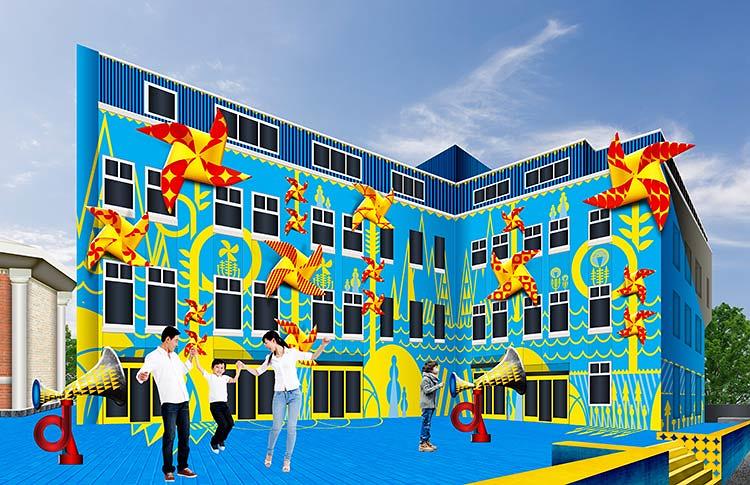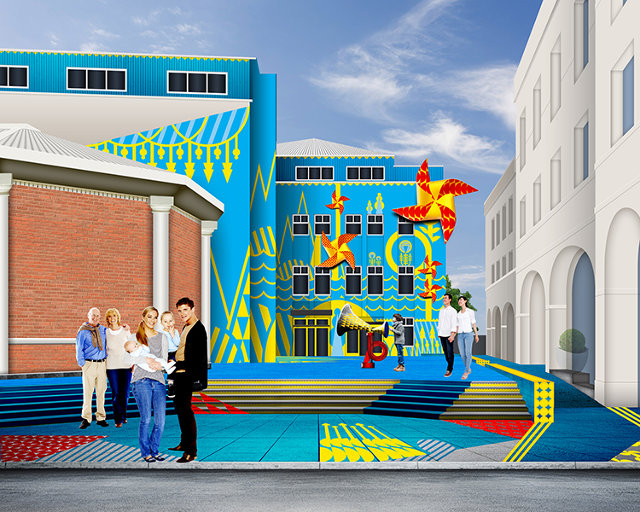Interaction with the outside of a building isn't something that happens often, unless the passerby takes a picture or points out the design to someone else. George Zisiadis wants to change that with his new design for the Santa Cruz Museum of Art and History.
His proposed design intends to place a 10-foot pinwheel on the side of the building that is connected to tubes in the plaza below. If a person blows in the tube, the pinwheel will start spinning. Zisiadis says that he wants the exterior to have some of the interactive elements that are featured inside the museum.
"They want people to engage with their art in a very hands-on way, which I find very empowering and inspiring," Zisiadis told Fast Company. "I wanted to extend this idea to the physical structure of the building itself.”
He wants to keep the mechanism driving the pinwheel mysterious in order to make the experience more fun for visitors, but it's pretty simple. When someone blows into the tube, hidden microphones pick up the sound and connected motors then make the pinwheel spin.
Zisiadis hopes that his design will encourage people to interact with the whole building and transform the way they perceive public space.
Related Stories
| Dec 27, 2011
Suffolk Construction celebrates raising of Boston Tea Party Ships & Museum cupola
Topping off ceremony held on 238th Anniversary of Boston Tea Party.
| Dec 27, 2011
State of the data center 2011
Advances in technology, an increased reliance on the Internet and social media as well as an increased focus on energy management initiatives have had a significant impact on the data center world.
| Dec 27, 2011
USGBC’s Center for Green Schools releases Best of Green Schools 2011
Recipient schools and regions from across the nation - from K-12 to higher education - were recognized for a variety of sustainable, cost-cutting measures, including energy conservation, record numbers of LEED certified buildings and collaborative platforms and policies to green U.S. school infrastructure.
| Dec 21, 2011
DOE report details finance options for PV systems in schools
The report examines the two primary types of ownership models used to obtain PV installations for school administrators to use in selecting the best option for deploying solar technologies in their districts.
| Dec 21, 2011
AIA Chicago & AIA Chicago Foundation 2011 Dubin Family Young Architect Award announced
The Dubin Family Young Architect Award is bestowed annually and recognizes excellence in ability and exceptional contributions by a Chicago architect between the ages of 25 and 39.
| Dec 21, 2011
Few silver linings for construction in 2012
On the brighter side, nearly half of respondents (49.7%) said their firms were in at least “good” financial health, and four-fifths (80.2%) said their companies would at least hold steady in revenue in 2012.
| Dec 21, 2011
Hoboken Terminal restoration complete
Restoration of ferry slips, expanded service to benefit commuters.
| Dec 21, 2011
BBI key to Philly high-rise renovation
The 200,000 sf building was recently outfitted with a new HVAC system and a state-of-the-art window retrofitting system.
| Dec 20, 2011
Gluckman Mayner Architects releases design for Syracuse law building
The design reflects an organizational clarity and professional sophistication that anticipates the user experience of students, faculty, and visitors alike.
| Dec 20, 2011
Research identifies most expensive U.S. commercial real estate markets
New York City, Washington, D.C. and San Mateo, Calif., rank highest in rents.



















